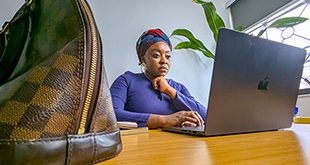
Paris, France | AFP | As COVID-19 deaths climb ever higher in Europe and the United States, millions of lives are at risk in developing nations where lockdowns and overwhelmed medical systems are disrupting vital testing, vaccination and treatment for other killer diseases.
The pandemic has seen unprecedented social distancing measures, with billions confined to their homes in a bid to stem the viral spread. Schools, businesses and public spaces have been shuttered en masse.
It has also fuelled unparallelled economic stimuli from governments and research funding to develop COVID-19 treatments and — the holy grail — a vaccine.
But while the world is focused on the novel coronavirus, other infectious diseases continue to kill millions of humans, many of them children.
Health experts warn that the COVID-19 pandemic is already denying untold numbers of patients treatment for illnesses such as tuberculosis, pneumonia and malaria.
The United Nation’s child care programme UNICEF said last month that 117 million children were now at risk of contracting measles as vaccination programmes are suspended.
“In some places routine services have been suspended also because the health systems are so stretched, all resources are being diverted to the COVID response,” Robin Nandy, head of UNICEF’s immunisation programme, told AFP.
“Countries want to limit the contact of health people with potential patients, and this has an impact on vaccination coverage.”
Measles killed more than 140,000 people in 2018, the vast majority aged under five.
– ‘Sleepless nights for a decade’ –
More than 2,500 children die every day from pneumonia — a bacterial infection treated with effective drugs that cost pennies. That’s more than 800,000 preventable child deaths a year, studies have shown.
In Nigeria, where pneumonia is the leading cause of under-five mortality, fears are growing that COVID-19 is already keeping infants from accessing live-saving interventions.
“We see a lot of children coming to clinics having respiratory problems and the issue is with diagnosis and treatment,” said Sanjana Bhardwaj, UNICEF chief of health in Nigeria.
“Another challenge is we do not have oxygen available across the country for children.”
And that was before the onset of COVID-19, a disease where treatment often requires placing patients on ventilators of oxygen.
“I’ve been having sleepless nights for more than a decade (about a pandemic),” Bhardwaj told AFP.
“When you’re at the frontline and you go into communities and see the healthcare there you just get scared.”
The Democratic Republic of Congo was suffering from multiple disease outbreaks even before COVID-19.
A measles epidemic there has killed more than 6,000 people — again, mostly children — since the start of 2019.
Malaria is a constant menace for infants in DR Congo and kills around 13,000 people there annually.
And last month the World Health Organization was forced to delay an announcement heralding the end of the country’s Ebola crisis as new cases were discovered.
“We already had significant morbidities such as malaria that was a huge problem, as well as malnutrition which really impacts children’s lives,” Alex Mutanganyi, Save The Children’s COVID-19 response coordinator in the country, told AFP.
“COVID-19 has just increased the threats that always existed.”
– Vaccine development, reach –
Billions of dollars are currently being funnelled to research for a COVID-19 vaccine, without which scientists doubt economies can fully return to normal.
More than 100 candidate vaccines exist, and around 70 of them are already being tested in clinical trials.
On Wednesday, the Stop TB Partnership warned that coronavirus lockdowns could lead to as many as 1.4 million additional tuberculosis deaths, as testing and treatment programmes are disrupted.
TB is the world’s biggest infectious disease killer, with around 10 million new infections and 1.5 million deaths annually.
Unlike COVID-19, effective, safe and cheap treatments for TB already exist.
The only current vaccine is more than 100 years old and only works on very young children. And despite being the deadliest infectious disease on Earth, TB research funding is still dwarfed by that given over to HIV and, now, COVID-19.
Lucica Ditiu, executive director of the Stop TB Partnership, said that it would cost around $500 million to finish developing a safe and universally effective TB vaccine.
“TB has been with us for thousands of years. For 100 years we’ve had an infant vaccine and we have two or three potential vaccines in the pipeline,” she said.
“We look on in amazement at a disease that is 120 days old and it has 100 vaccine candidates in the pipeline. This is really fucked up.”
Ditiu said that while governments are rightly focused on COVID-19, they mustn’t take their eye off of other communicable illnesses.
“TB doesn’t effect too many visible people. It’s a disease for people with other vulnerabilities, poor people, ones living in poor parts of the city,” she said.
“The fear we have is that developing a vaccine for COVID-19 now… may take the focus off of other diseases.”
Not that finding a safe and effective COVID-19 vaccine will be enough to guarantee an end to the pandemic.
“We need to be mindful that even with existing vaccines that we have had for decades, we’re still not reaching the populations that need them most,” said Nandy.
UNICEF said last month that around 20 million children worldwide were missing out on routine vaccinations, with 13 million never receiving immunisation.
“Developing a vaccine is not enough. Vaccines don’t deliver themselves. They need a functioning health system,” Nandy added.
– ‘Staying alive is work’ –
COVID-19 is not just exposing the gaps in global responses for communicable diseases. Hundreds of millions of people need daily medication to manage a host of chronic conditions, from diabetes to high blood pressure.
Last week the Non-Communicable Disease Alliance called on governments to ensure that people living with these illnesses can continue to receive vital treatment during the pandemic.
While estimates vary, it is thought that as many as 175 million people suffer from undiagnosed diabetes and up to one billion from undiagnosed hypertension.
Not only does this pose a hidden risk of COVID-19 complications for hundreds of millions globally, it also makes managing diagnosed disease harder.
Vicki Atkinson, a health campaigner with the South Africa NCD Alliance, said that the No. 1 killer among women there was diabetes — a condition that can be well managed with daily medication.
Atkinson, who herself suffers from diabetes and psoriasis, set up an information helpline so patients know how to access medical care during the lockdown. It was inundated with calls.
“One woman was told to take a taxi two hours to go to a regional hospital in Cape Town to pick up her medicine,” she told AFP.
“She is pregnant, on insulin and asthmatic. She didn’t want to do it.”
The NCD Alliance warned of “severe disruptions” to global supply lines of medicine and biomedical equipment due to COVID-19.
Atkinson and other health experts said the current pandemic had proven what they have been warning of for decades: the world is unhealthy, and health should not be taken for granted.
“Without this people would have carried on as normal,” she said.
“Across the board, we cannot pretend anymore. Chronic illness should be viewed as work. It’s work to stay alive.”
 The Independent Uganda: You get the Truth we Pay the Price
The Independent Uganda: You get the Truth we Pay the Price





